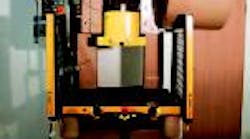Updated controls not only increase worker safety and improve productivity but provide additional enhancements, such as mechanical fault monitoring.
Safety concerns continue to rise in prominence, and perhaps in no other industry is this more relevant than that of metal stamping. The widespread use of hydraulics in stamping operations gives added importance to this concern.
In the U. S. alone, power presses cause 650 worker amputations annually, according to Jeff Ashcroft, of Penmar Automation, Newmarket, Ontario. "Many times, the culprits are older power presses that were built when the safety of workers was not as paramount as it is today. Many power presses still in operation are decades old because they continue to be productive."
So how do you bring these old workhorses up to today's safety standards without breaking the bank? Ashcroft says, "Microelectronic and digital controls can monitor operation and safety devices more effectively and reliably than the antiquated controls originally supplied by the machine. Press controls with diverse redundancy can now be employed quite cost effectively to provide an extra layer of security to help prevent accidents from occurring."
Furthermore, older controls are relatively easy for operators to defeat in attempting to increase production of a machine. And many owners have been hesitant to upgrade controls out of fear of becoming liable for 'tampering with' safety features originally designed into a machine.
Ashcroft continues, "OSHA in the United States and the CSA Provincial Labor Ministries in Canada have introduced safety codes that make the use of these modern technologies mandatory. Business operators who continue to ignore these codes and recommendations run the risk of heavy penalties — if not from the government, then from legal ramifications resulting from an accident."
But in addition to improved safety, says Ashcroft, upgraded press controls can increase the operational productivity of power press operations. "Automated batch counting and operation, combined with simplified error messaging and troubleshooting can allow operators to more quickly understand and correct press fault conditions, allowing them to get back to production mode. And device-net links from press controls can allow net-working of equipment to provide centralized data collection, operations monitoring, and die recipe control updates from PCs operating in an office."
Still another benefit is the ability to identify potentially serious mechanical malfunctions in their early stages, explains Ashcroft. This allows less costly preventive maintenance before a major power press breakdown and significant production interruption occurs.
An example of such a press control is the Command Stamp unit shown. Installed on a 1960s vintage 80-ton Minster Press, the control system was developed by Reflex Integration, a joint venture company of Penmar Automation and Soft Design Automation. This unit has been third-party verified to meet the CSA Z142-02 standard, which became mandatory this year.
Call Jeff Ashcroft at (905) 836-8103, e-mail [email protected], or visit www.penmarautomation.com
Get to know EthernetWAGO Corp., Germantown, Wis., has scheduled a free three-day seminar covering industrial Ethernet control. Attendees will receive an overview of industrial Ether-net components and protocols, learn about the company's hardware, participate in a hands-on IEC 61131-3 programming session with live demo nodes, and create web services and applications, such as alarm e-mails and web pages, from the controller. Time will be made available to discuss a variety of application examples, including any applications presented by attendees. The seminars will be held at WAGO's North American headquarters in Germantown. The next seminar is scheduled for October 25-27. The company also offers regional seminars throughout the country.To register on-line, visit www.wago.com; for additional information, email training manager Bill Tarpley at bill.tarpley@ wago. com, or call (262) 255-6333, extension 135. |


